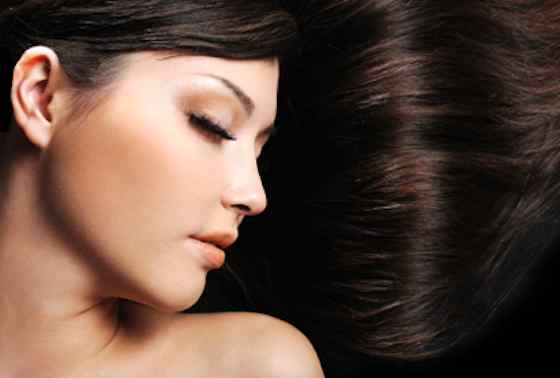- MENU
- HOME
- SEARCH
- WORLD
- MAIN
- AFRICA
- ASIA
- BALKANS
- EUROPE
- LATIN AMERICA
- MIDDLE EAST
- United Kingdom
- United States
- Argentina
- Australia
- Austria
- Benelux
- Brazil
- Canada
- China
- France
- Germany
- Greece
- Hungary
- India
- Indonesia
- Ireland
- Israel
- Italy
- Japan
- Korea
- Mexico
- New Zealand
- Pakistan
- Philippines
- Poland
- Russia
- South Africa
- Spain
- Taiwan
- Turkey
- USA
- BUSINESS
- WEALTH
- STOCKS
- TECH
- HEALTH
- LIFESTYLE
- ENTERTAINMENT
- SPORTS
- RSS
- iHaveNet.com
Bonnie Steele

Maintaining that healthy, manageable hair you get from hours at the salon requires work at home.
So how can you keep that high shine?
Conditioning your hair regularly will improve its strength, shine and keep hair damage to a minimum, though it can't actually repair damaged hair.
"Conditioners smooth the cuticles, reduce static electricity, protect against UV damage and enhance overall appearance," says Dr. D'Anne Kleinsmith, a dermatologist in West Bloomfield, Mich.
Conditioners also help keep the hair's cortex hydrated.
"Dry, out-of-condition hair lacks moisture, and without enough moisture, the number of hydrogen bonds may be reduced," explains John Gray, author of The World of Hair. "Conditioning allows reestablishment of the hydrogen bonds and improves the moisture content of the hair by improving the weatherproofing of the cuticle."
Your hair's length, the amount of chemical processing it endures and the frequency with which you use hot styling tools are all factors to consider in your conditioning regimen. "Ask yourself what kind of hair you have," suggests Steve Lococo, co-owner and style director of Borrelli Salons California. "Volume conditioners have ingredients that will plump up the hair, usually with grapefruit or some type of citric ingredient. Smoothing conditioners have a tendency to have more oils or lanolin to help coat the hair shaft."
Fine Hair
Thin hair typically cannot support a high level of conditioning ingredients. To prevent weighing down delicate tresses, consider conditioning just the middle and ends, where your hair is most susceptible to damage. A light volumizing conditioner will moisturize your hair and provide thermal protection for blow-dryer use. If your hair is extremely fine, you may want to replace a basic conditioner with a leave-in conditioning spray, which boasts a lighter formulation and will help strengthen the hair shaft.
Thick Hair
The right conditioner is a fundamental component of an effective hair care regimen if you have thick, wild tresses. "Unlike fine hair, hair that’s thick can support a lot of conditioning ingredients," explains leading hair care research scientist Steve Shiel. "I would recommend more intensive conditioning products; for example, one designed for straight hair or dry, damaged hair. Conditioning masks can also help to tame unruly hair." While a leave-in conditioner doesn't provide enough conditioning for thick hair, Shiel suggests using it as a detangling aid, especially on days between shampooing.
Curly Hair
“Condition, condition, condition” is the mantra for curly tresses. Hair experts suggest you condition your locks every time you shampoo. On the days you don't shampoo, run a conditioner through your corkscrews if they’ve gotten bulky and unkempt to help them relax and detangle easily. Rinse your scalp thoroughly but leave a trace of conditioner in your strands.
To avoid dehydration and frizz, use a deep-conditioning mask every two weeks. Maximize the results by applying the mask, then covering your hair with a shower cap or plastic wrap and running the heat of a blow dryer a few inches above your head for five to ten minutes. If your hair is extremely dehydrated, use a basic conditioner to detangle, followed by a leave-in conditioner to sustain moisture.
Colored and Highlighted Hair
Coloring your hair can remove some, or all, of the lipid layer on the surface of each cuticle, depleting your hair's natural waterproofing qualities. And since a basic conditioner is formulated to deposit on waterproof hair, it becomes ineffective on color-processed tresses. Conditioners specifically made for colored hair contain different polymers designed to work on a non-waterproof surface. Quick tip: the night before a color treatment, prep and protect your locks by coating with a leave-in oil, suggests Claudio Lazo, owner of C the Salon in Studio City, Calif.
Conditioning Tips for All Hair Types
Dispense the
conditioner into the palm of your hand and rub your hands together. Using your fingers almost like a comb, apply
the product from the midsections of your hair down toward the ends. "You
should concentrate on these areas, as they are the most damaged parts of your
hair," explains Shiel. "When you rinse your hair, enough of the
product will then deposit on the parts of your hair closest to your
scalp." You may also want to use a paddle brush or wide-tooth comb in the
shower to distribute the conditioner throughout.
Bonnie Steele is a Los Angeles-based freelance writer and the author of the romantic guidebook The Best Places to Kiss in Southern California: A Romantic Travel Guide
Available at Amazon.com:
The Best Places to Kiss in Southern California: A Romantic Travel Guide
WORLD | AFRICA | ASIA | EUROPE | LATIN AMERICA | MIDDLE EAST | UNITED STATES | ECONOMICS | EDUCATION | ENVIRONMENT | FOREIGN POLICY | POLITICS
Fashion & Style
Gorgeous Hair: Getting The Most from Conditioners